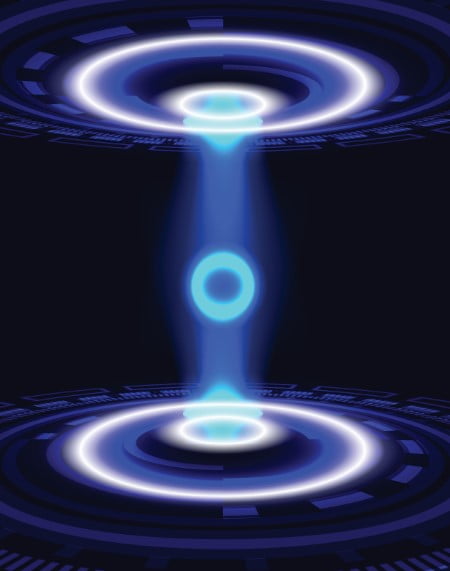Table of Contents
A Sneak Peek into Quantum Computing powered iPhone and Its Launch Date
iPhone is a household smartphone brand that leads the industry’s market share by 30.44% as of April 2023. In other words, for every 10 smartphone users, more than 3 would have an iPhone. Nevertheless, up until September 2021, Samsung, today’s runner-up, had a consistent run as the market leader. At the time of writing, iPhone 14 and its generation (iPhone 14 Plus, iPhone 14 Pro, and iPhone 14 Pro Max) are the flagships from the stable of American smartphone giant, Apple Inc. After redefining the smartphone industry with its series of touchscreen cellphones in 2007, the tech giant hasn’t shown any signs that it would rest on its oars. In short, every year ushers “Apple heads” into the latest version of its smartphone series, reflecting the company’s tech wizardry and its determination to remain the market trailblazer.

Released in September 2022, iPhone 14 features an iOS 16.0/16.6 – 17 operating system. Therefore, though the smartphone originally has a built-in iOS 16.0, you can upgrade it to iOS 17 and more. Thanks to this operating system, iPhone 14 boasts 2G, 3G, 4G and the latest 5G band technology! It is also worth mentioning that it has between 6GB and 128GB RAM, a hexa-core processor (2 x 3.23 GHz) and a non-removable Li-Ion 3900 mAh battery (iPhone 14 Pro Max comes with Li-ion 4323 mAh). Now, for a moment, think of the features your iPhone could have if it ran on quantum technology. Let’s call that next-gen series of smartphones Quantum Computing Powered iPhone’s. In this article, we will review some of the mind-blowing features they will come with and when we can expect them. Now, without much ado, let’s dive into this thought-provoking topic together.
Designing iPhones with Quantum Technology
When Apple Inc. starts rolling out iPhones engineered with quantum technology, you will notice these changes:
Processing Speed
Once again, iPhone 14 features a hexa-core processor (2 x 3.23 GHz), and many users believe that it is pretty fast. In fact, iPhone 14 Pro Max comes with a hexa-core processor (2×3.46 GHz Everest + 4×2.02 GHz Sawtooth). Irrespective of the yardstick used to measure these processors, they are pretty good for an iDevice built around the principles of classical computing. However, Quantum iPhones will be incredibly faster than those in use today. That’s because quantum technology’s building blocks (qubits) are way faster than classical devices’ bits.
In the United Kingdom, Prof Jeremy O’Brien, director of the Centre for Quantum Photonics at the University of Bristol, assembled a team to advance the use of quantum technology in smartphones. During the study, Professor O’Brien built photo-channelling quantum circuits from silicon, thereby opening up the possibility of mass-producing quantum chips used with ordinary microelectronic components. The research has progressed over time and the team has used silicon to manipulate light, thus producing circuits over 1000 times more complex than today’s glass-based technology. Therefore, silicon-based quantum computing (QC) is a next-gen technology you should look out for. Much as it is unrealistic to state the processing speed of the first Quantum iPhone, there is no denying the fact that it will be much faster than the current speed of iPhone 14 and its ilk.

Relax, let’s give you more insights into it. IBM Quantum, the leading QC maker, uses a superconducting transmon qubit made from superconducting materials like niobium and aluminum patterned in silicon substrate. Already, Apple Inc. engineers developed the iPhones we use today with millions of silicon microchips. Indeed, that technology isn’t going away anytime soon as it will be used in Quantum iPhones. Like the classical counterpart, Quantum iPhone will be packed with millions, if not billions, of qubits with connecting wires in the microchip circuitry. Silicon is the preferable material for producing qubits because its infrastructure is already available – since it is also used in conventional devices. Aside from enabling infrastructure, silicon will work well for that purpose because qubits need to be close to one another to share information. The challenge now is placing wires between each pair so they can share information. To this end, researchers from the University of New South Wales (UNSW) have shown that jellybean quantum dots were possible in silicon. This allows silicon to be spaced approximately to connect and control the qubits without hitches. Without a doubt, this inches us closer to engineering a Quantum iPhone whose processing speed will be faster than the combined speeds of all the classical devices out there.
Battery Life
As an iPhone user who regularly reads our QC blogs, we assume you already know what to expect when quantum computers go ubiquitous. However, what you may not know yet is how it will impact your preferred smartphone. The good thing is that the emerging technology will certainly improve your smartphone if you care about having a long-lasting battery like most people do. As you already know, one of the challenges Apple Inc. has tried to deal with over the years is designing smartphones that come with long-lasting batteries. In fact, it is not uncommon to see iPhone heads carry power banks and chargers everywhere they go. That’s commonplace because their smartphones’ batteries can go flat anytime. Apple’s flagship iPhone 14 has an installed battery capacity of 3900 mAh and may last an average of 13.5 hours, depending on use. Nonetheless, with quantum technology being the foundational blocks of your iPhone, you will realise that it lasts longer because the rapidly evolving technology processes data at an ultrafast speed. Put simply, the more you use your handset, the more likely it is to run down. But with Quantum iPhones hitting the markets, you will see positive changes. Think of it this way: your phone will last much longer if it can accomplish more tasks with minimal computational energy. Yes, this is the edge quantum technology brings to the iPhone technology.
Security and Data Privacy
One unique feature that endears iPhones to their users is topnotch security. Truly, you can set up your encryption using a passcode or Touch/Face ID technology that locks and unlocks your iDevice whenever you want to. Remember, your iPhone maintains pictures, transaction details, contacts and emails. Hence, it is critical to encrypt such information to avert unauthroised persons from accessing them. iPhones come with tamperproof security, thanks to the AES 256-bit encryption that gives a layer of security for data storage. With the encryption technology, your smartphone protects your data when the iDevice is not in use. Without encryption, data stored on your phone would be in its original form. Now, once you encrypt your data, it means you have scrambled it, and you can only read the data when you decrypt it. The encryption key is associated with the passcode when it is generated. Guess what, tech pundits suggest that quantum technology can shatter today’s encryption technology, allowing random people access to your data.
Are you about to get jittery? Do not, because Quantum iPhones avert stop it! This is particularly true because quantum cryptography is the game-changer. Quantum encryption uses the naturally occurring properties of quantum mechanics to secure and transmit data in ways nobody can infiltrate or hack it. When Quantum iPhones go commercial, quantum encryption will play the role of today’s encryption technology. You guessed it right – the quantum encryption principles hinge upon the tenets of individual particles of light or photons, thereby making it too hard to crack. Photons are used in this early-stage encryption technique because physicists understand that they can carry discrete information through optical fibre cables.
Quantum Intelligence
Before smartphones took the centre-stage in the 2000s, little was known about their futures. Today, we gaze in awe as they unfold. One of them is artificial intelligence (AI), which makes them perform their functions much smarter. Since AI chatbots and other apps took over the tech world, many iPhone users are impressed with what their smartphones can do. But what if we tell you that your smartphone can do much more if it runs on quantum technology? Yes, quantum intelligence is no mirage! The truth is, AI is just getting started because developers are working hard to enhance existing applications and systems. AI’s untapped potential is significantly harnessed in quantum intelligence. In short, one of the major drawbacks militating against AI today is the limitation of computational capabilities. No doubt, it is a challenge quantum intelligence will tackle head-on because quantum technology gives QC systems (your iPhone inclusive) the enablement to run computational functions at a breakneck speed.
So, once quantum technology begins to power your iDevice, you will notice that its computational potential has multiplied. Guess the outcomes – it reduces AI learning time and revs up the processing time of AI applications and systems. As you already know, developers train AI tools to display the level of intelligence that it does today. However, quantum AI will improve the current AI, ensuring Quantum iDevices display unprecedented degrees of intelligence. That’s because developers can train its neural network in real time. In the near future, your Quantum iPhones will be “more intelligent” than the smartphones available in today’s online and brick-and-mortar stores.
Quantum Cloud Computing
Back to the basics, cloud computing means providing services such as data storage, databases, servers and networking over the Internet. Instead of storing data on physical devices or servers onsite, you can opt for cloud technology to cut hardware maintenance and other costs. With what we know today about cloud computing, it is safe to say that Quantum iPhones will come with cloud computing; this is known as quantum cloud computing. Once they go commercial, Quantum iPhones will run faster with computing power higher than the current iDevices. This cheering news means that you won’t lose those breathtaking features that swept you off your feet about iPhones in the first place. That’s because you can use cloud computing services and solutions.
Several QC companies already provide quantum cloud computing services, allowing clients and other users to access quantum processors, simulators and emulators through the cloud. The good thing is that today’s quantum computers already feature quantum cloud computing. According to IBM, the quantum hardware system is about the size of a car as it comes with several components, including cooling systems that keep the qubits (built from superconducting elements) at the ideal operating temperature for optimal capacity. When Quantum iPhones hit the mom-and-pop stores, they will feature quantum cloud technology, allowing users to leverage the technology to explore various quantum computing applications.
When Should We Expect Quantum iPhones?
We can answer, “Soon!” However, you can argue that “soon” is vague. Admittedly, that is true. Size, in truth, is one obstacle delaying the use of quantum technology in mobile devices. For instance, while computer engineers make the transistors in classical devices in nanometers, the superconducting qubits are measured in millimetres. Nonetheless, there are ongoing studies to reduce bulky quantum systems and shrink them into portable, sleek devices (such as iPhones and iPads). In one study, MIT researchers are looking at the possibility of using ultrathin materials to build superconducting qubits. Once they achieve this feat, these superconducting qubits will replace transistors and chips.
Still on the study, the MIT researchers disclosed that the hexagonal boron nitride, a material made of the monolayers of atoms, can be designed to form the insulating components of superconducting qubits’ capacitors. Those materials allow miniature capacitors to replicate what qubits do without hampering the device’s performance. Today, a typical QC system that can perform basic functions measures between 5 feet and 20 feet long. Plus, they often require cooling systems to keep the qubits at an optimally low temperature.
However, we have seen Quantum Brilliance, an Australian-German QC hardware company, develop a quantum computer that has the size of a lunchbox and can run at room temperature. Therefore, there are strong indications that launching Quantum iPhones and iPads will be feasible in a few decades. But for Prof O’Brien and his team, this could happen within a decade! So, we keep our fingers crossed and bring you the industry’s momentous events here as they play out!
About the author: Ashwin Saxena
Founder, of Cybranex Technologies and consultancy pvt ltd, is a physicist with a strong background in deep theoretical physics and a passion for scientific understanding.
Ashwin had the vision to pursue a PhD in an application-oriented branch of physics-oriented towards societal growth, and while working towards this goal, developed an interest in interdisciplinary research and development infrastructure. As he neared the end of his PhD, he decided to put his vision into action by starting a company in the relevant technological domain.


